Expression profiling during mammary epithelial cell three-dimensional morphogenesis identifies PTPRO as a novel regulator of morphogenesis and ErbB2-mediated transformation
- PMID: 22851698
- PMCID: PMC3457532
- DOI: 10.1128/MCB.00068-12
Expression profiling during mammary epithelial cell three-dimensional morphogenesis identifies PTPRO as a novel regulator of morphogenesis and ErbB2-mediated transformation
Abstract
Identification of genes that are upregulated during mammary epithelial cell morphogenesis may reveal novel regulators of tumorigenesis. We have demonstrated that gene expression programs in mammary epithelial cells grown in monolayer cultures differ significantly from those in three-dimensional (3D) cultures. We identify a protein tyrosine phosphate, PTPRO, that was upregulated in mature MCF-10A mammary epithelial 3D structures but had low to undetectable levels in monolayer cultures. Downregulation of PTPRO by RNA interference inhibited proliferation arrest during morphogenesis. Low levels of PTPRO expression correlated with reduced survival for breast cancer patients, suggesting a tumor suppressor function. Furthermore, we showed that the receptor tyrosine kinase ErbB2/HER2 is a direct substrate of PTPRO and that loss of PTPRO increased ErbB2-induced cell proliferation and transformation, together with tyrosine phosphorylation of ErbB2. Moreover, in patients with ErbB2-positive breast tumors, low PTPRO expression correlated with poor clinical prognosis compared to ErbB2-positive patients with high levels of PTPRO. Thus, PTPRO is a novel regulator of ErbB2 signaling, a potential tumor suppressor, and a novel prognostic marker for patients with ErbB2-positive breast cancers. We have identified the protein tyrosine phosphatase PTPRO as a regulator of three-dimensional epithelial morphogenesis of mammary epithelial cells and as a regulator of ErbB2-mediated transformation. In addition, we demonstrated that ErbB2 is a direct substrate of PTPRO and that decreased expression of PTPRO predicts poor prognosis for ErbB2-positive breast cancer patients. Thus, our results identify PTPRO as a novel regulator of mammary epithelial transformation, a potential tumor suppressor, and a predictive biomarker for breast cancer.
Figures
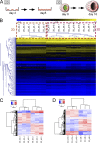
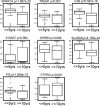
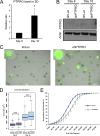

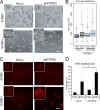
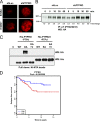
Similar articles
-
PTPRO represses ERBB2-driven breast oncogenesis by dephosphorylation and endosomal internalization of ERBB2.Oncogene. 2017 Jan 19;36(3):410-422. doi: 10.1038/onc.2016.213. Epub 2016 Jun 27. Oncogene. 2017. PMID: 27345410 Free PMC article.
-
ErbB2 requires integrin alpha5 for anoikis resistance via Src regulation of receptor activity in human mammary epithelial cells.J Cell Sci. 2010 Apr 15;123(Pt 8):1373-82. doi: 10.1242/jcs.050906. Epub 2010 Mar 23. J Cell Sci. 2010. PMID: 20332114 Free PMC article.
-
LOXL2 induces aberrant acinar morphogenesis via ErbB2 signaling.Breast Cancer Res. 2013;15(4):R67. doi: 10.1186/bcr3461. Breast Cancer Res. 2013. PMID: 23971878 Free PMC article.
-
Tumor-Suppression Mechanisms of Protein Tyrosine Phosphatase O and Clinical Applications.Asian Pac J Cancer Prev. 2015;16(15):6215-23. doi: 10.7314/apjcp.2015.16.15.6215. Asian Pac J Cancer Prev. 2015. PMID: 26434819 Review.
-
ErbB2 activation and signal transduction in normal and malignant mammary cells.J Mammary Gland Biol Neoplasia. 1996 Apr;1(2):199-206. doi: 10.1007/BF02013643. J Mammary Gland Biol Neoplasia. 1996. PMID: 10887493 Review.
Cited by
-
PTPRO represses ERBB2-driven breast oncogenesis by dephosphorylation and endosomal internalization of ERBB2.Oncogene. 2017 Jan 19;36(3):410-422. doi: 10.1038/onc.2016.213. Epub 2016 Jun 27. Oncogene. 2017. PMID: 27345410 Free PMC article.
-
Oxaliplatin induces different cellular and molecular chemoresistance patterns in colorectal cancer cell lines of identical origins.BMC Genomics. 2013 Jul 16;14:480. doi: 10.1186/1471-2164-14-480. BMC Genomics. 2013. PMID: 23865481 Free PMC article.
-
A Novel Effect of β-Adrenergic Receptor on Mammary Branching Morphogenesis and its Possible Implications in Breast Cancer.J Mammary Gland Biol Neoplasia. 2017 Mar;22(1):43-57. doi: 10.1007/s10911-017-9371-1. Epub 2017 Jan 11. J Mammary Gland Biol Neoplasia. 2017. PMID: 28074314
-
Epigenetically silenced PTPRO functions as a prognostic marker and tumor suppressor in human lung squamous cell carcinoma.Mol Med Rep. 2017 Jul;16(1):746-754. doi: 10.3892/mmr.2017.6665. Epub 2017 May 31. Mol Med Rep. 2017. PMID: 28586036 Free PMC article.
-
The tyrosine phosphatase PTPRO sensitizes colon cancer cells to anti-EGFR therapy through activation of SRC-mediated EGFR signaling.Oncotarget. 2014 Oct 30;5(20):10070-83. doi: 10.18632/oncotarget.2458. Oncotarget. 2014. PMID: 25301722 Free PMC article.
References
-
- Bentires-Alj M, Neel BG. 2007. Protein-tyrosine phosphatase 1B (PTP1B) is required for HER2/Neu-induced breast cancer. Cancer Res. 67:2420–2424 - PubMed
-
- Bild AH, et al. 2006. Oncogenic pathway signatures in human cancers as a guide to targeted therapies. Nature 439:353–357 - PubMed
-
- Chen L, Juszczynski P, Takeyama K, Aguiar RC, Shipp MA. 2006. Protein tyrosine phosphatase receptor-type O truncated (PTPROt) regulates SYK phosphorylation, proximal B-cell-receptor signaling, and cellular proliferation. Blood 108:3428–3433 - PubMed
Publication types
MeSH terms
Substances
Grants and funding
LinkOut - more resources
Full Text Sources
Other Literature Sources
Medical
Research Materials
Miscellaneous
